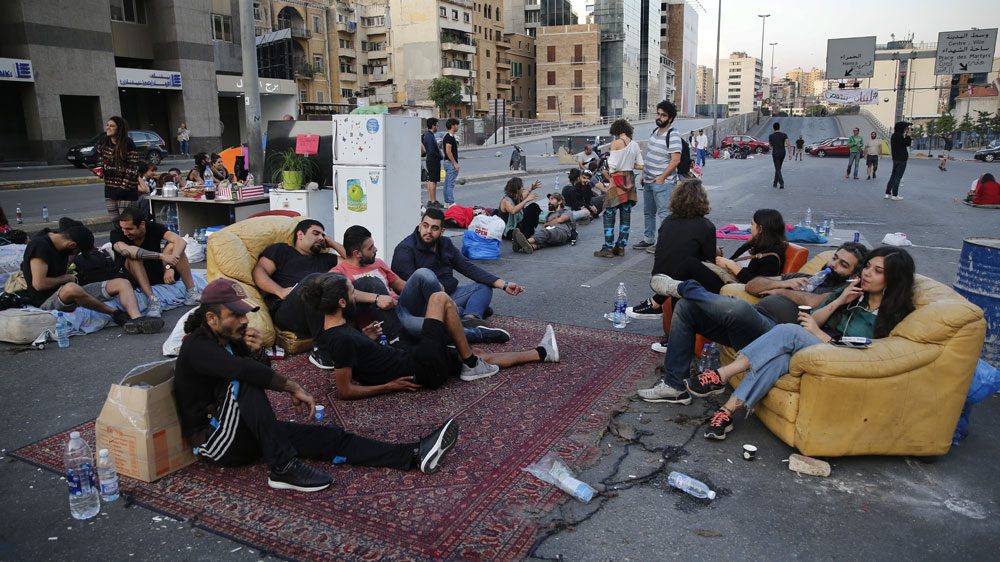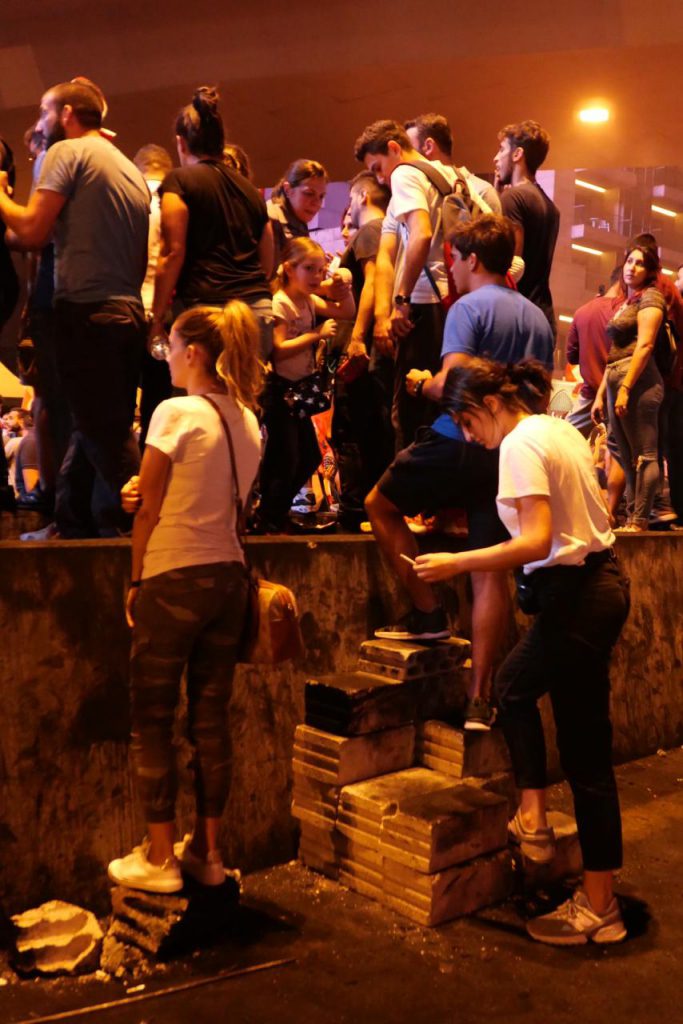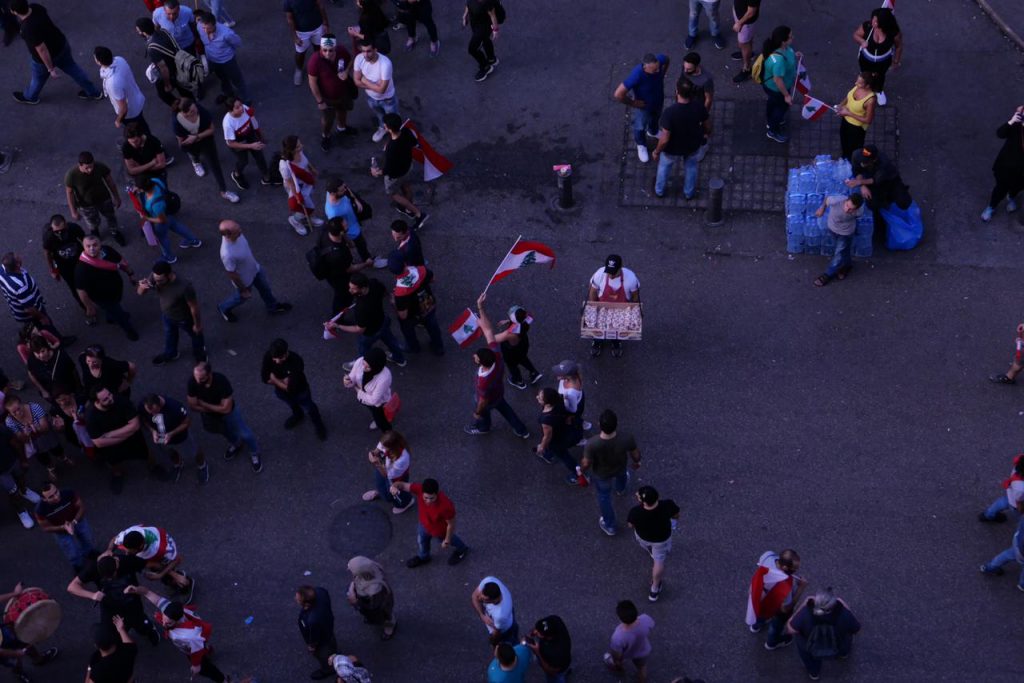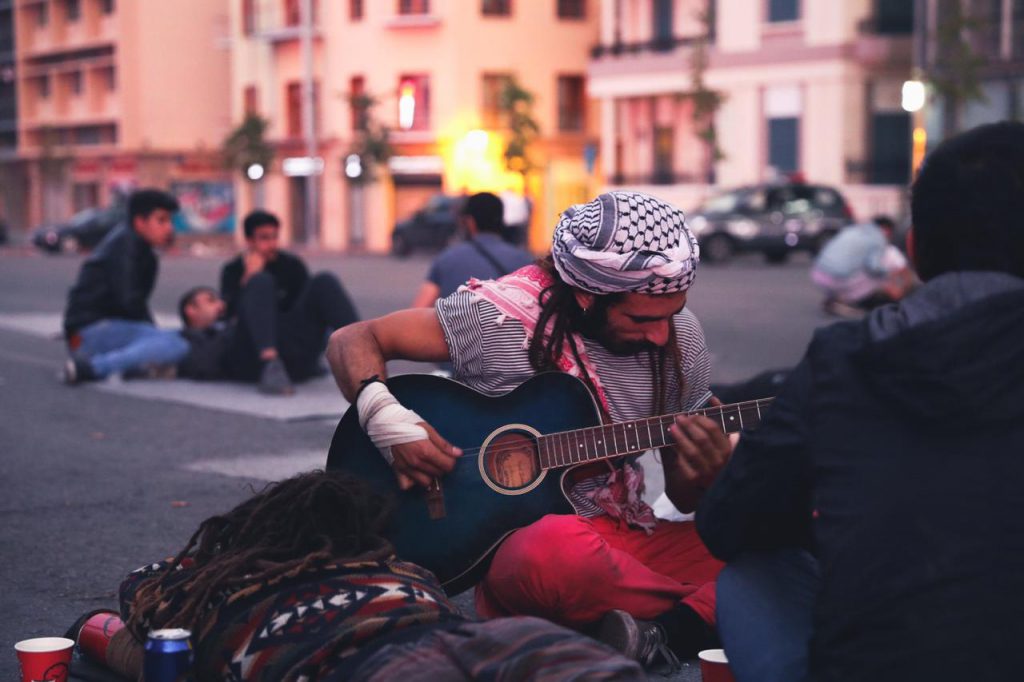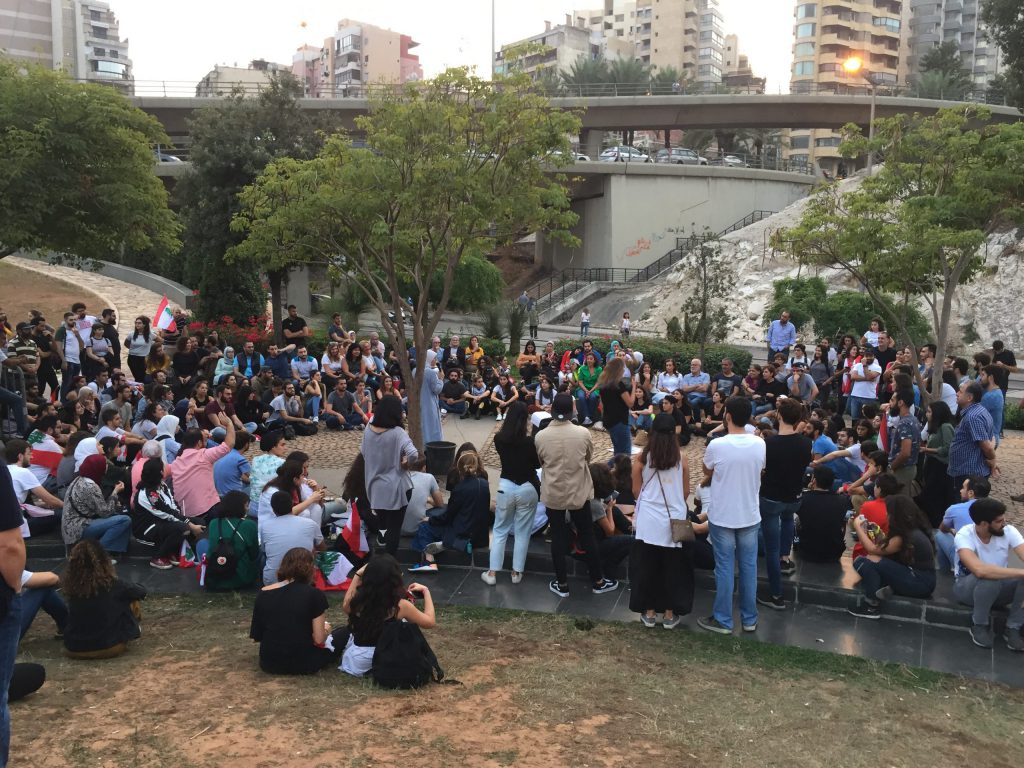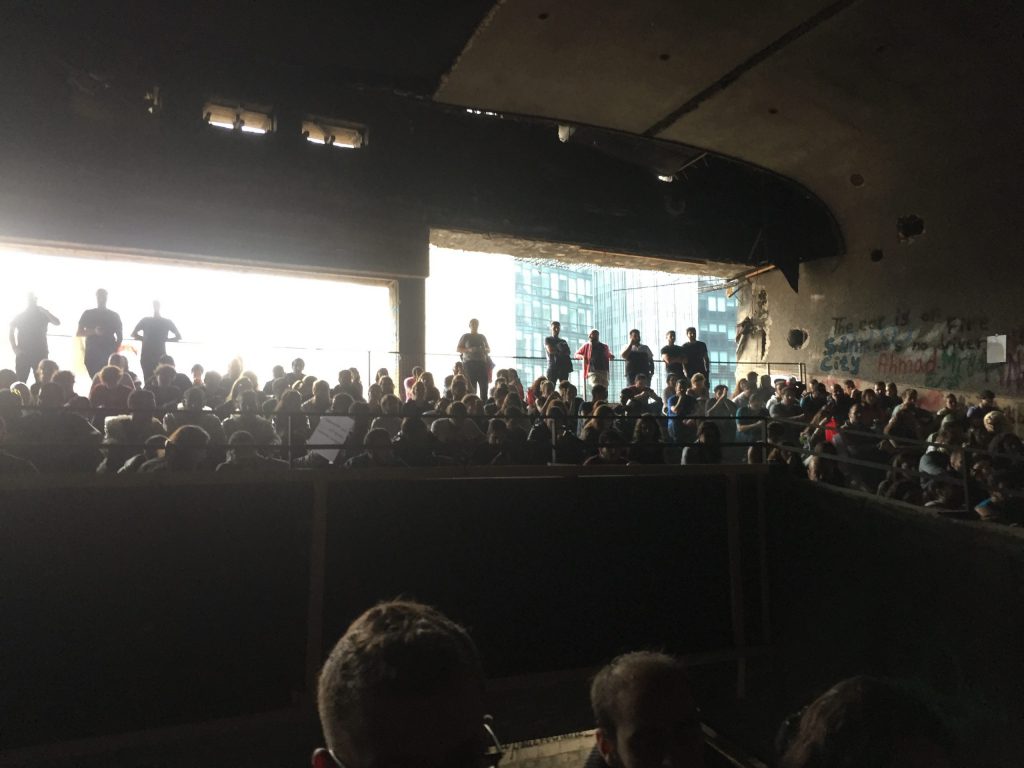In Lebanese history, October 17 marks the beginning of a long overdue revolution that is engraved in our minds for several reasons. Citizens (and expatriates) from all over the country have put aside their sectarian affiliations, taking to the streets to voice the urgency of overthrowing the existing political regime. The ongoing rebellion has single-handedly restored hope in the country’s future, and rekindled light in our eyes, one that had been dimmed down for decades.
Albeit, this uprising is peculiar. Not only is it carried out in a peaceful almost celebratory manner, allegorizing deliverance, but the multi-generational proactiveness encountered is unprecedented. While the focus is on the dissolution of the government, the fundamental motivation lies in the quest for basic human rights.
There are essential rights that we, the citizens of Lebanon are not attuned to or aware of, one of which is the primordial right to public space –public meaning “open, free, accessible to all.”
A multitude of spaces considered public exist in Lebanon –roads including sidewalks, bridges, corniches, and beaches– but the country significantly lacks social and cultural public spaces intended for assembly purposes or, on a more general note, for pedestrians.
This is due primarily to an exponential capitalist urbanization that favors private developments and real estate over public domain. The most flagrant example is that of our Downtown. After the war in 2006, destruction ravaged our nation and a reconstruction plan of our City Centre was eventually put in place.
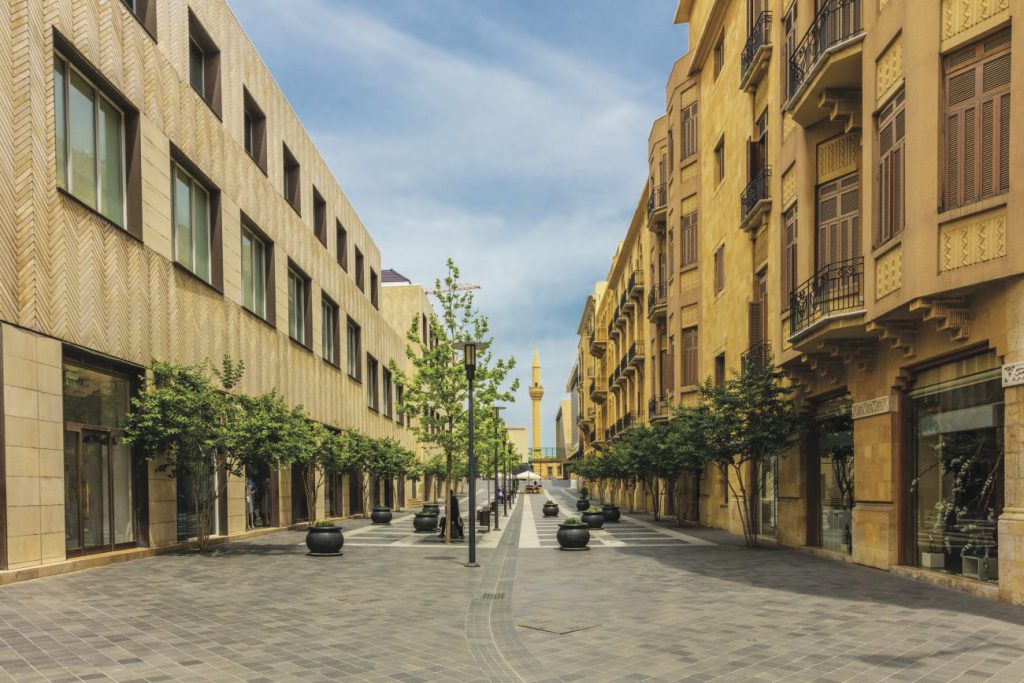
What had been a popular historic, cultural space adorned with local merchants and street vendors was morphed into a high-end commercial centre with luxury brands that only an elite minority could afford. Nevertheless, a few “public spaces” were created, most of them small, hidden, manicured, uninviting. Some even look like they belong to the private domain.
Since manifestations are held in open-air and require considerable areas fitting a sizeable number of protesters, an inherent demand for public space suitable for big gatherings became chief. With the obvious lack of adequate places and an exponentially growing community with an agenda, the journey to reclaiming spaces was swiftly launched.
The Street: Genesis
Now, instead of avoiding big crowds, we seek them.
Naturally, the first public domain that pedestrians reclaimed was the street. In an unapologetic manner, hundreds of thousands, with their flags held high and proud, invaded and consequently colonized the roads.
Instead of being confined to tiny sidewalks, pedestrians took over whole streets and replaced the usually predominant cars. A feeling of security was instilled. Even the cars that were still circulating, although in a significantly reduced number, adopted a much slower pace, instinctively safeguarding the marching protesters. Civilians finally started feeling welcomed on the streets, where a sense of belonging and reclamation was gradually cultivated within them.
The effects of the pedestrian monopoly were numerous and directly noticeable. First and foremost, an almost obsolete activity was rediscovered: walking. The mere idea of wandering around Beirut is almost inconceivable these days, and even more so is traveling from one destination to another by foot.
Why? For lack of security due to an excess of cars and insufficient lighting and regulations, pollution, inadequate and deficient infrastructure. In Beirut, the inherent general structure is centered around vehicles. You can see it on the shrinking sidewalks, augmented roads, and added highways. Everything previously mentioned, combined with the alarming lack of public transport, resulted in an individualistic automobile culture. Today, there exists on average two cars per household. As a result, it shouldn’t come as a shock that walking was rarely a lucrative option up until October 17.



Today, people are walking everywhere: alleyways, lanes, roads, avenues, boulevards, and even inside tunnels and on bridges and highways. Fast lanes became either slower or still. Motorcycles multiplied. Carpooling increased. Hitchhiking occurred as well, proving how safer people felt with each other.
Individuals would also meet up and park their vehicles wherever they could find a place at a considerable radius from their locations and continue to their respective destinations on foot. To reach Downtown for example, they would march either from Sodeco, Achrafieh, Monot, Mar Mkhayel, Bechara el Khoury, Mathaf, Hamra, Ain el Mraysseh or even Jal el Dib.
Those distances that were once thought to be substantial, and sometimes unimaginable, by foot gradually shrunk in our minds with the passing days.
We were so accustomed to getting from point A to point B using the fastest route, certainly by car, with the main goal to impatiently evade traffic.
Now, instead of avoiding big crowds, we seek them. The closing of roads pushed us to discover –or rediscover– our city in a new light and on a humane scale. Instead of experiencing the city at a rapid pace, we slowly explore it as a public space, noticing more and more of its elements every time. Consequently, we have developed a better understanding of our environment and the varied connectivity it offers. We are not threatened by distances anymore.
Highways: From dynamic to static
Ironically, contested spaces became the spaces for contesting.
Because of their ability to host the swelling number of activists and because of their primary purpose of ensuring connectivity, highways were best suited for the needs of activists.
The Dorah-Jounieh Highway is the only direct path that connects the north of Lebanon to its south, so it is understandably essential. Activists obstructed it in progressively different ways. The first two days, people stopped the circulation of traffic by burning tires. Then they parked their cars transversely, turning it into a massive parking lot. When more and more demonstrators showed up, their mere physical presence was the only thing that needed to be done to achieve the tactic.
The highway started holding several gatherings and sit-ins at the heart of Jal El Dib. Stairs formed of stacks of stones were assembled to facilitate crossings on different levels. Chairs and tables were also set up and a static place was created.
The Jal el Dib bridges, usually always empty, filled up with civilians who wanted a top view of what was happening on the highway beneath them. Originally, construction of the bridge was halted by local protesters who were against its proposal for many practical reasons. Ironically, contested spaces became the spaces for contesting. Bridges came to be emblematic for the Matn area.



In this case, the reappropriation of the space was done in a transgressional manner, overturning the intended function of the public space and transforming it into another. However, the conversion from dynamic to static space was accomplished by merely adding portable furniture for a temporary lapse of time. Nothing was physically altered nor destroyed.
A similar process occurred at the intersection of General Fouad Chehab Avenue and George Haddad Road, commonly referred to as ‘The Ring’. In both publicly reclaimed highways and crossroads, a series of activities blossomed, and an unprecedented typology of ephemeral space was conceived and experienced.
Squares: From static to dynamic
Squares were offsetted into the streets.
The revolution is additionally unique because of its decentralized nature. Instead of taking place in only one “administrative” center, which would naturally be the center of the city, our Downtown, the whole country is seemingly mobilized.
However, there are key locations where the demonstrations are thriving: In Tripoli, in Abdul Hamid Karami Square also known as Sahet el Nour, in Beirut, Riad el Solh and Martyr’s Square, in Sidon, Elia Square, in Tyre, Al-Alam Square and in Nabatieh.
Even though the word “square” exists at the end of each of those titles, their everyday use, or lack there-of, strays away completely from what a square is supposed to embody.
Urban squares are defined as spaces, usually publicly-owned, that constitute central locations or “focal points” in the city where communities feel safe to practice all sorts of formal or informal social, cultural, and economic activities.
In Lebanon, those squares are particularly poorly-conceived, relatively small, and uninviting. On normal days, they are empty. Most of them don’t fit the description mentioned above, primarily lacking safety since they are delimited by very busy roads or even at the center of substantial roundabouts or crossroads. In fact, Abdul Hamid Karami Square is in its essence a roundabout with up to seven lanes.
Post-October 17,with the streets being inhabited by the people, a very particular phenomenon took place: These squares were offsetted into the streets and doubled or tripled in size to better fit the rioting population. The only physical limits became the buildings, which were even accessed, when vacant, in order to gain a panoramic strategic view from above.



As a result of the revolution, those previously abandoned squares gained span and regained purpose and life. Today, they are thriving. While the first step to the reappropriation of public space was triggered by marching, what ensued became even more representative of this happening. The occupied areas provided a colossal forum for exchange. An emblematic example is that of our Downtown.
Downtown As A Public Space
Less of a transitional space, and more of a destination.
Before October 17, upon arriving to Downtown, emptiness and parkings heavily-prevailed. Except for the occasional Beirut Souks visits, the center of the city became less and less of a destination, and more of a transitional space that connected one place to another.
After October 17, parkings that previously took huge proportions served immensely in the expansion of squares. The markers on the floor demarcating car parking spots ceased to exist in people’s minds. Parkings became part of public space and became a place for people instead of vehicles.
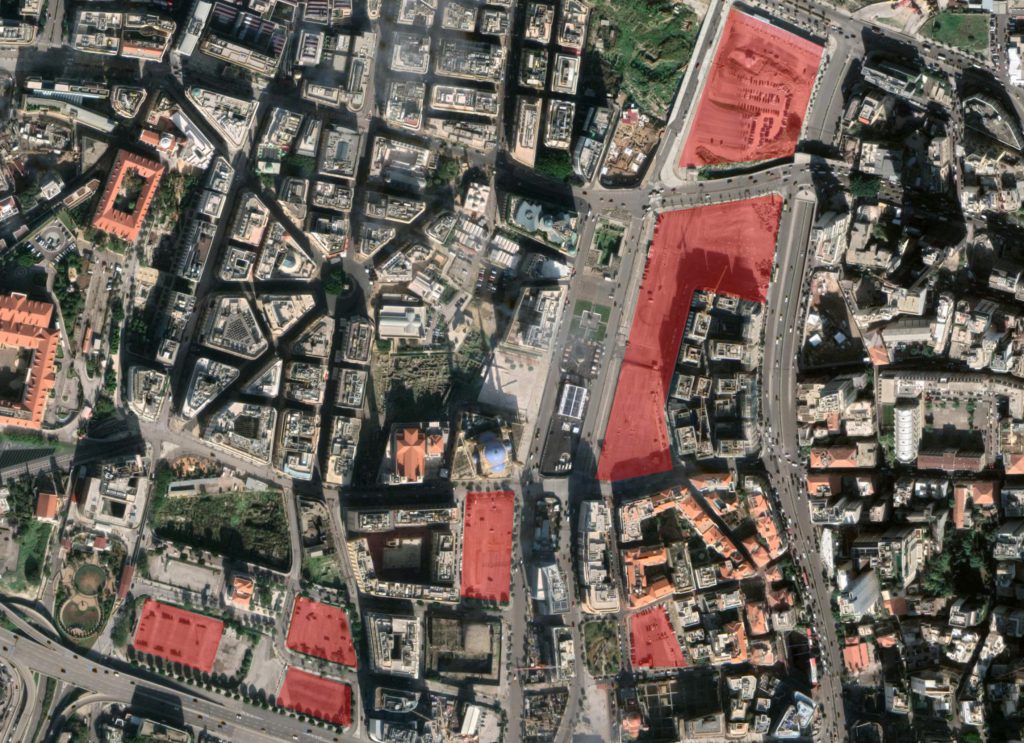


However, post-October 17, the extension previously discussed expanded to a point where Martyr’s Square, Riad el Solh, and the Ring were encompassed.
This power trio (Martyr-Riad El Solh- Ring) became the siege of a palette of events, a platform for reuniting protesters. A symbiosis between individuals with religious, political, economic, financial and cultural differences occurred: A Lebanese melting pot was formed. Action was immediately taken, which leads us to wonder about the ways through which people reclaimed these three different public spaces?
Social Activities: Motors of the revolution
A series of personal observations made on the spot or through social media
For this revolution to last, people knew that they had to put in the work to reclaim abandoned spaces. They were eager to do so. Social and cultural activities commenced.
First came the chanting, and the flags, and the determination. Bonds were directly tied between people from polar backgrounds and from all ages. Street vendors and local merchants, previously unwelcome, confidently installed their stands and provided protesters with a palette of food, beverages, and Lebanese engraved trinkets, at extremely low prices.It should be noted that within days those prices escalated profusely.
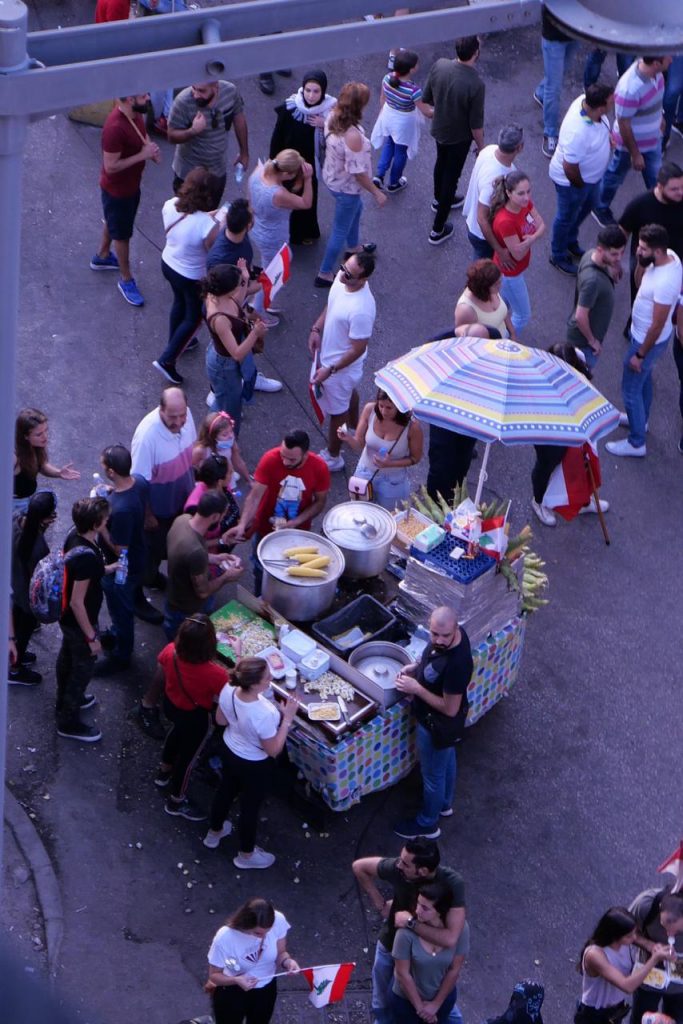


People were even selling hookahs, which slowly became another emblem of the revolution. Since the existing infrastructure was immensely insufficient, kiosks were laid down, tables were mounted, and chairs were found à go-go. People who didn’t have tables used their car trunks. Others would even use present scaffolding to sit or stand on. Everyone was making do. Even portable bathrooms were installed.
An almost carnival-like atmosphere prevailed. Stages were constructed. Consequently, a platform for people to express themselves was created, either through words, or poems, or music. Arabic songs were constantly played, and new artists, notably from the underground rap scene emerged.
The events were organized and coordinated. Tents were mounted either on grass or asphalt for the people who were spending the nights in order to facilitate their stay. “Beit el Cha3eb,” a furnished wall-less apartment with a living room, mattresses, and even carpets was installed on the Ring and open for everyone. Leisure activities flourished: some were playing cards and board games, others who favored sports brought their equipment and practiced tennis, and yoga. A slackline was installed. A football field was traced in the Ring and matches were held. Someone even set up an inflatable pool.
At night, the activities would interchange. Free live concerts and raves took place. The techno scene also resurfaced. Alcohol was sold. When it got dark and streetlights were nonexistent or failing, people lit up the place and made it safe again with the flashlights on their phones, their cars headlights or even with stage lights.
Big personal events also occurred: Weddings, proposals, and birthday celebrations. Everything was done on our streets. Even a human chain of 170,000 people, connecting the country’s north and south, was successfully accomplished. People knew that something bigger than them was happening.
The city rose. For the first time in ages, people were dancing, chanting, laughing, crying, walking, playing, sitting, talking. In Downtown, the stairs of El Amin-Mosque were sat and stood on, as were the slopes of the Rafic el Hariri Memorial, the lawn of the Martyr’s Square and Park Charles Debbas, or even the benches of Samir Kassir Square. People were laying down on the asphalt or utilizing whatever infrastructure was available. Even Uruguay Street regained its grandeur.
The loud noises and livelihood encountered brought back the nostalgic souvenir of the Nejmeh Square in its primetime, when it was a safe popular space for everyone. It’s as if it had been relocated. The Downtown reclaimed its original calling: by the people and for the people. And when came the morbid day of October the 29, where a destruction unraveled in the Martyr’s square, people wasted no time to rebuild everything that had been lost. They even kept a symbol of the incident in the form of a sculpture and placed it in front of the burned revolution hand to symbolize their strength and resilience.
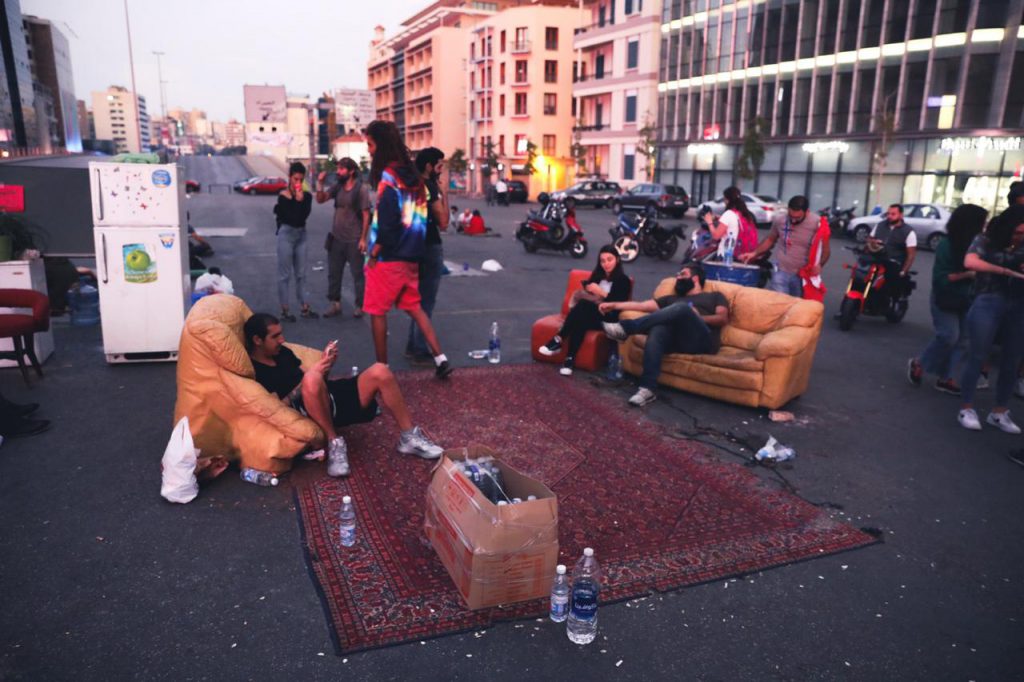


Art: Colonizing the streets
Living signs that fossilize in a city.
If the walls could talk, they would say heaps. Graffiti populated walls: paintings, writings, caricature, slogans, and slurs of all shapes and colors were added on almost every single surface. Art happened everywhere, in an ornamental, intrinsic or vandalistic manner, depending on how one sees it.
Writer and agitator Raoul Veneigem referred to graffiti as “forbidden gestures,” “living signs” that fossilize in a city, and confer citizens a sense of property of the places). That said, was the graffiti necessary to showcase the voice of protesters or was this artistic expression taken a bit too far?
Initiatives: Proactive generations unfolding
Younger generations took the lead.
Multiple initiatives were created on the spot. The revolution instilled in people a sense of ownership of their reclaimed spaces, which resulted in an utmost respect for and a need to take care of and protect them.
Daily cleanups were organized each morning, and copious amounts of trash were recycled. First aid kits were available. Even psychological aid was offered, rightfully so since protests are mentally draining. People distributed free food and clothing to those in need.
In an environmentally-conscious manner, water was installed in tanks to avoid plastic bottles, solar panels were set up, and vegetation was added in the form of plants to make up for the lack of greenery. A group of young people even cleaned the walls of the Saint Georges Maronite Cathedral and the El- Amin Mosque, controversially deeming the graffiti disrespectful.
But the most prominent initiatives that appeared were the ones that offered the possibility of finding solutions to the ongoing crisis. Teachers, academics, professors, and specialists organized daily conferences, proposals, programs, teach-ins, free to the public, to discuss and debate the situation.
Talks were held in open-air, in kiosks, in parks, in abandoned buildings, and in gardens. For example, meetups took place in the Gebran Khalil Gebran Garden, a manicured public space that almost no one knew existed before the protests.
This proactiveness was particularly noticeable among younger generations, which came up with most of these initiatives.
In the case of Riad el Solh and Martyr’s Square, the reappropriation of the space was different. Since it forms the geographical, historical and administrative heart of the capital, local manifestations were always held there. In this case, there was no real misappropriation or modification of function. The reappropriation was similarly done by addition of retractable furniture. But unlike in Jal el Dib, destruction and damaging of properties occurred during the first few days: breaking infrastructure, shattering lobbies of a residential building, graffiti –actions that could be considered questionable, but also salvageable.
The choice of place for these manifestations was purely strategic, not platonic or void of connotation. This is primarily the reason why they were the ones that constituted the main protest zones, and not other existent public spaces such as Corniche El-Manara or Hamra.
Abandoned Spaces: Icons of the Revolution
Abandoned buildings were re-accessed and repurposed.
A rather renowned abandoned space that was also reappropriated is that of the iconic Egg, previously known as the “Beirut City Center”. Part of a multi-use complex conceived by Joseph Philippe Karam in the 60s, it is mostly recognized as an old cinema and its “egg” appellation derives from its shape.
Located in the heart of Downtown, it was run down by age and war. Today, it opened its “doors” and welcomed hundreds for occasions varying from screenings and conferences to raves and parties. The Egg was also climbed and painted as an icon of the revolution. Notably, the rave held raised some serious questions about the structural capacities of the building and the risk of exacerbating its condition.
Other abandoned buildings were re-accessed and repurposed such as the “Grand Theatre des Milles et Une Nuits,” built in the 30s by the famous architect Youssef Aftimos who also conceived the Barakat building, future Beit Beirut.



The Teatro al-Kabir, iconic landmark was abandoned after the civil war and closed to the public by Solidere. Since 1990, debates on its future were conducted. It was doomed to become yet another boutique hotel, inaccessible to the public. Meanwhile, it held numerous meetings and sit-ins, and welcomed an opera singer, Michel Roger, who expressed himself amidst the ruins and restored the building’s former glory for a moment before it was re-closed for safety purposes.
Abandoned landmarks formed the icons of the Revolution. In fact, it is in those places where the biggest and most versatile reclamation happened, the first act committed being the reactivation of the space. This suggests that the abandoned obsolete spaces of a city are in general where it is truly rebirthed. It’s where true investment sparks and a true recuperation begins.
Social Media: Freedom of coverage
Reclaiming virtual spaces.
It is important to note that not only physical space was reclaimed, but virtual spaces too. Politics used to constitute a taboo topic of discussion. Now, political affairs are the only thing people seem to be talking about.
Facebook, WhatsApp and Instagram have become platforms for not only sharing art and jokes, but also for shedding truths surrounding recent revolutionary events. Articles, photographs, drawings, and most significantly videos are constantly communicated all throughout the world and serve as a means to convey the facts both nationally and internationally.
What’s next?
History is being made.
It’s been over a month since the beginning of the Revolution, and it seems that the adventure is far from over. With every passing day taken to write and rewrite this article, various events are happening that I personally felt the need to add gradually: history is being made.
As seen, the reclaiming of the public spaces depended primarily on their nature. It was done in various ways either in a natural manner, concordant, additive, transformative, or transgressional.
“Reclaiming urban public space, means reclaiming it in every sense, reclaiming the right to walk, to stroll, to loaf, to sit alone, to hang out with others, to wander, to get lost, to be visible, to be invisible, to use a toilet, to just be, in all those spaces, at all hours,” and the right to protest.
The reclamation of public space in the October 17 revolutions helps confer a clue of the endless opportunities for the future of our cities and our country. What is transpiring can be regarded as a crash course that restored hope in the potentialities of Lebanon.
In a matter of weeks, we developed tools, persevered, and grew. We simulated the functioning of our city on a micro-scale. While the activities and reclamation process have so far been promising, they are also ephemeral because they are taking place during a specific event. They are not long term. People have dedicated their entire time to protest and closed down everything from companies and public offices to schools and universities.
This festival-like state will realistically not subsist. Nor will the drive and proactiveness stay exactly the same. This raises the following questions: What’s next? What can we learn from the revolution? How can what’s happening now help us generate a more cohesive and inclusive future?


